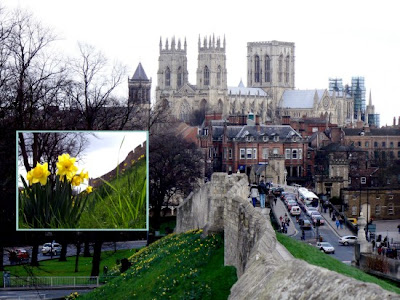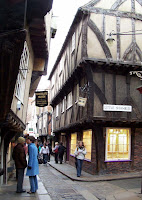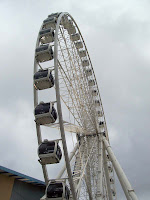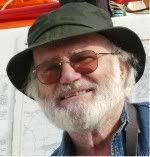Tuesday 20 November 2007
Saturday 10 November 2007
Chesterfield's pre-Christmas Market washout.

Most of the 200 stalls in this normally bustling market were empty on this Sunday in November 2007, when the pre-Christmas market should have been in full swing. Constant heavy rain kept the crowds and many of the traders away.


 ABOVE: "Never mind the rain, dear."
ABOVE: "Never mind the rain, dear."I got very wet, but was happy with the picture opportunities that presented themselves on this rainy day.
RIGHT: Even Chesterfield's famous crooked spire seemed to be sagging in the wet.
BELOW: A local professional band playing 1950s Rock 'n' Roll brightened the day. I lived in Derbyshire in those days, and this excellent performance took me back to the first time I heard these now classic songs, and I suddenly felt 50 years younger.

Wednesday 24 October 2007
Greenwich: Home of Whitebait Dinners

The Trafalgar Tavern overlooks the River Thames close to the former Royal Naval College (now the campus of The University of Greenwich), the National Maritime Museum and the site of the ill-fated historic tea clipper, The Cutty Sark.
Built in 1837 the tavern became popular with authors such as Dickens and Thackeray, and inspired Dickens as the setting for a scene in his novel Our Mutual Friend. Politicians of the day, including Gladstone and Pitt, attended Whitebait Dinners there, with fish caught from the Thames.
Towards the end of the 19th century, the building was turned to other uses including a seamen’s institute and a working men’s club, but reopened in 1965 after restoration to its former glory.

 Nearby pubs include The Cutty Sark, serving 'doorstep sandwiches' and The Yacht, offering traditional fish and chips.
Nearby pubs include The Cutty Sark, serving 'doorstep sandwiches' and The Yacht, offering traditional fish and chips.Greenwich now awaits restoration of the fire-ravaged ship, The Cutty Sark, which was built 32 years later than the Tavern and came to its land-locked dry dock in 1954.
Labels:
Cutty Sark,
fish and chips,
Greenwich,
pub,
pubs,
ship,
tavern,
Trafalgar,
whitebait,
yacht
A Visit to Burns Country
On a brief visit to Scotland earlier this year I was able to spend an hour in Ayr, remembered for its connections with Robert Burns.

The town is full of relics and memories of the famous Scottish poet, with many landmarks named after him and his works. The photograph on the right shows the Tam O' Shanter Inn, recalling the eponymous hero of the epic poem, and below is an illustration from a booklet on sale in the visitor centre, illustrating Tam's flight from the witch, Nannie, wearing a short chemise, or 'Cutty Sark. This was the inspiration for the figurehead of the famous tea clipper, which shows her holding the horse's tail. (See lower photograph).
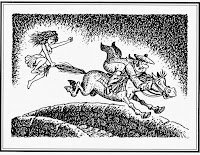

The town is full of relics and memories of the famous Scottish poet, with many landmarks named after him and his works. The photograph on the right shows the Tam O' Shanter Inn, recalling the eponymous hero of the epic poem, and below is an illustration from a booklet on sale in the visitor centre, illustrating Tam's flight from the witch, Nannie, wearing a short chemise, or 'Cutty Sark. This was the inspiration for the figurehead of the famous tea clipper, which shows her holding the horse's tail. (See lower photograph).

The tower in the photograph above is in memory of William Wallace, who was given the title 'Guardian of Scotland' for his leadership of the rebels who defeated the English army at the Battle of Stirling Bridge in 1297. 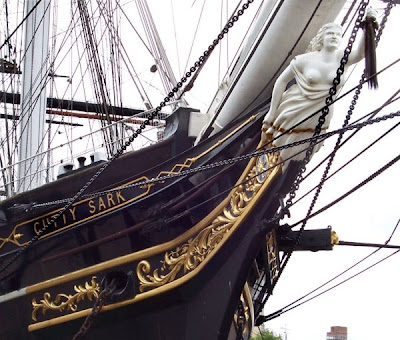

The Cutty Sark at Greenwich before the fire
x
Labels:
Ayr,
Cutty Sark,
Greenwich,
London,
Robert Burns,
Scotland,
William Wallace
The City of York
Dry Stone Walls

DRY STONE WALLS are as common in the highland areas of Britain as are hedges in the lowlands. I photographed these in the Yorkshire Dales. Dry stone walling is an ancient craft in which no cement is used, but the walls are extrtemely strong.

Torquay at Night
ALWAYS LOOK ON THE BRIGHT SIDE . . .
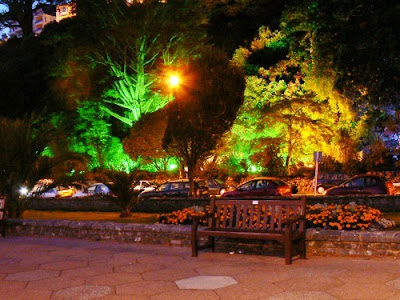
We all need a bit of colour in our lives now that the nights are drawing in, so here are some of last autumn's 'holiday snaps'.


We all need a bit of colour in our lives now that the nights are drawing in, so here are some of last autumn's 'holiday snaps'.

A Borders Holiday
BORDERS HOLIDAY, DAY 1
The coach tour to the Borders country looked good in the travel brochure, was less expensive than the cost of petrol and hotel accommodation bought separately, and it’s a long way from East Anglia to the Scottish border (close on 400 miles each way, and then some touring to do) so I decided to let the professional driver take the strain.
At the end of the 10-hour journey (including two stops for the driver’s rest periods) we arrived at the Swallow Hilltop Hotel at Harraby on the edge of Carlisle. The hotel, which opened in 1970, looked tired and so did the staff, perhaps not yet recovered from the excitement of the previous evening when a wedding party turned into a riot and the bride had the unenviable experience of spending her ‘first night’ alone while the groom languished in a police cell.
Harraby Hill, we soon learnt, had seen unhappy experiences before, when it was called Gallows Hill. 20 Jacobites were hanged there in 1746 for their part in the ‘45 rebellion, when Bonnie Prince Charlie briefly held the castle, one mile away.
was called Gallows Hill. 20 Jacobites were hanged there in 1746 for their part in the ‘45 rebellion, when Bonnie Prince Charlie briefly held the castle, one mile away.
Putting aside the thought of sleeping on the site of such grisly happenings I turned to the view from my window: a modern retail park with the ubiquitous Tesco , B&Q et al, standing on land formerly occupied for more than a century by one of the seven railway companies which once served this great city at the gateway between England and Scotland and contributed to its industrial wealth.
After an excellent dinner somebody suggested a stroll into the city to unwind after so many hours sitting still on our journey north, but only four of us braved the walk into the city centre, past derelict and near-derelict shops, presumably forced out of business by the greedy conglomerates, as is typical of most urban areas nowadays. The only people we saw on the way were the inevitable groups of teenagers in shabby jeans, expensive ‘trainers’, and baseball caps at every angle other that for which they were designed. They looked lost, standing expressionless, except when we walked into the road to pass them, when they managed an inane grin, accompanied by farmyard sounds.
Walking in the road was a risky business because of the activities of ‘boy racers’ burning rubber as they accelerated and skid-turned, but it was, after all, around 9 pm, and the streets belonged to them and the presence of police cars parked outside the County Constabulary a short distance away did not worry them.
but it was, after all, around 9 pm, and the streets belonged to them and the presence of police cars parked outside the County Constabulary a short distance away did not worry them.
It took about 20 minutes to reach the city centre, passing between the twin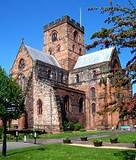 towers of the ancient Citadel, now rebuilt and housing council offices, then through the modern shopping centre to visit the 12th century cathedral, the second smallest in England. It was closed of course, at that time of night, but perhaps there would be another opportunity during the week. We also had a brief glimpse of the castle across the ring road, and that too was ‘pencilled in’.
towers of the ancient Citadel, now rebuilt and housing council offices, then through the modern shopping centre to visit the 12th century cathedral, the second smallest in England. It was closed of course, at that time of night, but perhaps there would be another opportunity during the week. We also had a brief glimpse of the castle across the ring road, and that too was ‘pencilled in’.
So ended day one of the tour, and I was ready for bed when we got back to the hotel.
The coach tour to the Borders country looked good in the travel brochure, was less expensive than the cost of petrol and hotel accommodation bought separately, and it’s a long way from East Anglia to the Scottish border (close on 400 miles each way, and then some touring to do) so I decided to let the professional driver take the strain.
At the end of the 10-hour journey (including two stops for the driver’s rest periods) we arrived at the Swallow Hilltop Hotel at Harraby on the edge of Carlisle. The hotel, which opened in 1970, looked tired and so did the staff, perhaps not yet recovered from the excitement of the previous evening when a wedding party turned into a riot and the bride had the unenviable experience of spending her ‘first night’ alone while the groom languished in a police cell.
Harraby Hill, we soon learnt, had seen unhappy experiences before, when it
 was called Gallows Hill. 20 Jacobites were hanged there in 1746 for their part in the ‘45 rebellion, when Bonnie Prince Charlie briefly held the castle, one mile away.
was called Gallows Hill. 20 Jacobites were hanged there in 1746 for their part in the ‘45 rebellion, when Bonnie Prince Charlie briefly held the castle, one mile away.Putting aside the thought of sleeping on the site of such grisly happenings I turned to the view from my window: a modern retail park with the ubiquitous Tesco , B&Q et al, standing on land formerly occupied for more than a century by one of the seven railway companies which once served this great city at the gateway between England and Scotland and contributed to its industrial wealth.
After an excellent dinner somebody suggested a stroll into the city to unwind after so many hours sitting still on our journey north, but only four of us braved the walk into the city centre, past derelict and near-derelict shops, presumably forced out of business by the greedy conglomerates, as is typical of most urban areas nowadays. The only people we saw on the way were the inevitable groups of teenagers in shabby jeans, expensive ‘trainers’, and baseball caps at every angle other that for which they were designed. They looked lost, standing expressionless, except when we walked into the road to pass them, when they managed an inane grin, accompanied by farmyard sounds.
Walking in the road was a risky business because of the activities of ‘boy racers’ burning rubber as they accelerated and skid-turned,
 but it was, after all, around 9 pm, and the streets belonged to them and the presence of police cars parked outside the County Constabulary a short distance away did not worry them.
but it was, after all, around 9 pm, and the streets belonged to them and the presence of police cars parked outside the County Constabulary a short distance away did not worry them.It took about 20 minutes to reach the city centre, passing between the twin
 towers of the ancient Citadel, now rebuilt and housing council offices, then through the modern shopping centre to visit the 12th century cathedral, the second smallest in England. It was closed of course, at that time of night, but perhaps there would be another opportunity during the week. We also had a brief glimpse of the castle across the ring road, and that too was ‘pencilled in’.
towers of the ancient Citadel, now rebuilt and housing council offices, then through the modern shopping centre to visit the 12th century cathedral, the second smallest in England. It was closed of course, at that time of night, but perhaps there would be another opportunity during the week. We also had a brief glimpse of the castle across the ring road, and that too was ‘pencilled in’.So ended day one of the tour, and I was ready for bed when we got back to the hotel.
Labels:
45 rebellion,
Bonnie Prince Charlie,
Borders,
Carlisle,
Castle,
Cathedral,
Citadel,
Harraby,
railway
Subscribe to:
Posts (Atom)

